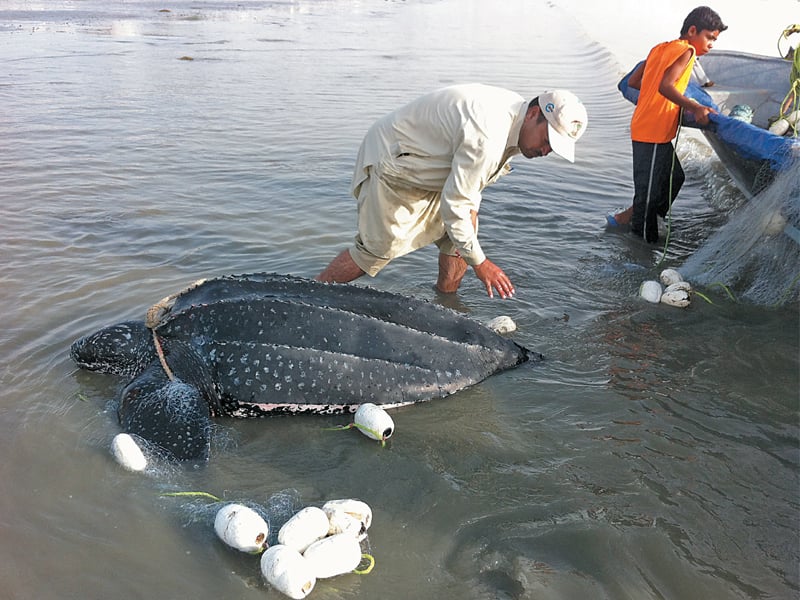
The country’s coastline boasted of five species of marine turtles but one of them, the leatherback, was never spotted live before - until Tuesday when a group of fishermen caught one at Gwadar.
Green turtles, olive-ridley, hawksbill and loggerhead are among the others also found along the Pakistan coastline, but the leatherback is considered one of the most rare species, not just in the country, but across the globe.
On Tuesday, a group of fishermen operating a monofilament gillnet caught a large leatherback turtle at Gwadar near Surbandar village. Since the turtle was stuck inside their net, the fishermen brought the turtle to the beach, after which the World Wildlife Fund - Pakistan (WWF-P) helped them rescue it and release it back into the sea.
According to WWF-P technical adviser on marine fisheries Muhammad Moazzam Khan, leatherback turtles are very rarely found in the coastal areas of Pakistan. They have been spotted four or five times before but they were all dead.
“It is our luck that leatherback turtles exist in our sea as these are signs of the existence of life in natural position,” Khan said.
WWF-P has trained the fishermen, who venture out into the sea, to make sure they don’t harm the wildlife that is not of interest to them, such as turtles and whales. “We are happy that our fishermen now have a sense of the value of marine life.” The young fishermen had no recollection of leatherback turtles, but the older ones remember seeing them.

The fishermen sacrificed an expensive gillnet, worth nearly Rs14,000, to save the turtle, pointed out WWF-P’s coordinator at Gwadar Abdul Rahim. Fishermen now release the turtles safely if they are enmeshed in their gillnet and other fishing gears and do not fling the turtle as they used to, he added.
The turtle that was released into the sea 30 minutes after it was found weighed around 400 kilogrammes. “Almost 90 per cent of the leatherbacks diet comprises jelly fish, which have gained in numbers significantly along the coast of Sindh and Balochistan in the past 10 years,” he explained. “This may be one of the reasons that they managed to grab the turtle.”
Khan and his team will study the coastal belt and carry out further research on this species of marine turtles.
According to WWF-P director Rab Nawaz, the sighting of a live leatherback turtle is a good omen for the country’s biodiversity. His team recently located a large population of olive-ridley turtles from offshore waters of Pakistan, which were believed to be extinct. A dead leatherback was once spotted at Pushukan near Gwadar in 2002.
Nawaz pointed out that recent estimates show that this species is declining precipitously throughout its range of distribution.
He stressed the need for all stakeholders including fishermen, wildlife departments and NGOs take necessary steps to protect these turtles. He suggested monitoring nesting beaches and patrolling them to protect mothers from scavengers including feral dogs.
This species is largest of marine turtles
The Leatherback turtle (Dermochelys coriacea) is the largest marine turtle, in fact the largest reptile, according to a WWF-P press statement. It is mostly widely distributed in Indian and Pacific oceans, including North Sea. In the Arabian Sea, it is found in India, Oman, UAE and Yemen, but it is the rarest of all species of turtles in the area.
Leatherback turtle can grow up to 900kg and has a teardrop shaped body. According to WWF-P director Rab Nawaz, leatherback turtles have survived for more than a hundred million years, but are now facing extinction.
The global population of this species was estimated to be 115,000 adult females in 1982, said WWF-P technical adviser on marine fisheries Muhammad Moazzam Khan, adding that the number went down to 40,000 by 1996. Leatherback populations in the Indian Ocean have undergone dramatic declines in the past 40 years. The nesting colony at Terengganu, Malaysia, went from more than 3,000 females in 1968, to 20 in 1993, to just two recorded recently.
With additional input from WWF-P press release
Published in The Express Tribune, April 18th, 2013.
COMMENTS (13)
Comments are moderated and generally will be posted if they are on-topic and not abusive.
For more information, please see our Comments FAQ




1725967717-0/Untitled-design-(3)1725967717-0-165x106.webp)












@Pagal Parinda. no the turtle didnt harm me . But its rare and its our duty to 'preserve' these creatues. Lets put it in a huge spacious place where it can roam freely and breed( if possible ) with other creatuers of its own kind. It can make a good study for children and adults alike. Once its back in the Arabian sea, we might not get to see it again. Worse - it might fall prey to poachers. Many rare land and water creatures are kept in acquarium world wide. its not being cruel. Its called 'preserving' .
@stranger Why do you want to put this turtle in an aquarium? What harm has it done to you? Would you like it if someone puts you in the aquarium? Let this poor turtle go free....
This is indeed a remarkable act of kindness and social responsibility that should serve as a glowing example to a terribly 'me-only' society. I salute these foshermen for such a selfless act and certainly hope that the WWF will compensate them and publicise their example far and wide, up and down the coast.
Kudos to the fishermen. Lets hope the Leatherbacks increase their visits to our shorelines.
I never knew something like Leather back turtle existed. I hope not only these turtles will be preserved but also the coast line of Gawadar too.
WWF should have provided something in return for this generous act of the fishermen. This would encourage them to do similiar kind of acts in the future.
Lets put such turtles and other rare species in some secured place like some huge spacious breeding acquarium etc., It should be shown to students and children . If its back in the ocean , we might not get to see it again.
Pak Fishermen freed them, a very very good news for starting a day. Good going Pakistan keep it up
Gulam Rasool"Kuldeep sharma" New Delhi
If it's a rare species then it would have been sensible for the WWF to put a tracker on the turtle, in hope that it helps dig more info about the species and its way of living.
Problem is if they start giving "incentive" for bringing in & putting back these rare species, everyone will be out their looking to capture these animals then seeking reward to set it free.
Can the WWF-P or somebody at least reimburse (if not a small reward) the fishermen for the gillnet (quite expensive for them, relatively) so as to induce encouragement of such acts?
These fishermen receive no incentive by the local govt. and will have to put it back in the ocean out of their own awareness and goodwill, unlike in western countries.
Put it back in the ocean!!!